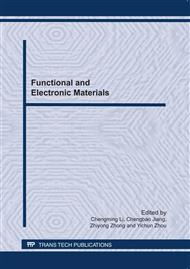p.138
p.144
p.151
p.158
p.163
p.167
p.174
p.179
p.183
Resistive Switching and Current Conduction for Thermally Grown NiO Thin Film
Abstract:
The unipolar resistive switching (URS) properties were investigated for NiO thin film prepared by thermal oxidation of the deposited Ni layer on Pt substrate. The turn-on voltage (Vset) shows apparent variation, at which switching from a high-resistance state (off) to a low-resistance state (on) occurs. The formation and rupture of a conducting channel are commonly proposed to explain the bistable conduction states, so called the filament model. The Vset polarity and instability are discussed in the light of the filament model and the results agree with the p-type carriers known in NiO film. Current-voltage data of the on-state conduction in full-log scale follow the ohmic behavior and the temperature dependence shows the relatively stable essence. The off-state current displays space-charge limited (SCL) relation at higher field and reveals a positive temperature dependence. The dominance of the off-state conduction for resistance swtich effect is emphasized and analyzed using the impedance spectroscopy.
Info:
Periodical:
Pages:
163-166
Citation:
Online since:
June 2011
Authors:
Keywords:
Price:
Сopyright:
© 2011 Trans Tech Publications Ltd. All Rights Reserved
Share:
Citation:


